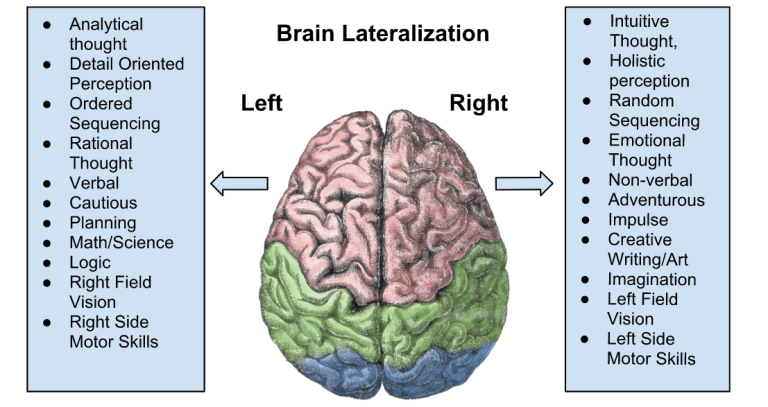Effective Methods To Overcome Procrastination
“Procrastination is opportunity’s assassin”
– Victor Kiam
Read this article to the end to learn how to master the cancerous habit of procrastination. Do this and you will finally regain control of your life.
Split-Brain Patients and the Interpreter Module
How do you stop someone from having severe epileptic fits?
You split their brain into two.
That’s exactly what surgeons did in the 1950s. The corpus callosum is a large bundle of neurons that connect the left and right hemispheres. It’s the bridge that allows both sides of the brain to communicate.
When this is severed surgeons can stop seizure activity spreading from one hemisphere to another. Patients can then live normal lives.
Well, almost normal.
Our brain’s hemispheres are actually responsible for different functions. For example, the left can interpret language much better than the right. While the right can recognize faces much better than the left. The right hemisphere is responsible for the left side of your body, while your left hemisphere is responsible for your right.
In the 1960s, Rodger Sperry and Michael Gazzaniga designed a series of experiments where split-brain patients were shown different inputs to the different hemispheres. The inputs were delivered in a way that would be received by one hemisphere and ignored by the other.
The results were startling, showing that when the brain is split the person is effectively divided into two or more different people. Each hemisphere can have different desires, perceptions and beliefs based on what it sees.
It appeared that people were divided in a mental tug of war as the hemispheres could not communicate with each other.
In one experiment the scientists asked a patient via the right hemisphere to stand up and walk to the door. Once standing they then questioned him via the left hemisphere about what he was doing.
The appropriate answer would have been “I don’t know.”
But the subject replied with, “I’m going to get a coke.”
It turns out that our brains are very good at rationalizing our actions through self-deception. This self-deception is more obvious in split-brain patients, but normal individuals are not immune.
After years of research Gazzaniga concluded that our brains have what he calls the ‘interpreter module’. Its job is to make sense of and rationalize our experiences.
But what does this have to do with procrastination?
Often when we procrastinate, we tend to rationalize a way out of doing the work we know we should do. When we tell ourselves we will do the cleaning tomorrow, or that something else is more important right now, we are deluding ourselves just like the split-brain patients.
If our explanations for postponing work are even remotely believable our brains will fall for the bait every time.
This is the first trap for procrastinators.
Understand that there might be two or more versions of you inside your brain – each with its own agenda.
Commitment Devices
In many supermarkets a family-sized block of chocolate is the same price as a smaller block. You might be surprised that the smaller blocks tend to sell out quicker than the bigger ones. Rational people would buy the bigger block, save money and simply ration the chocolate out over the course of a few days.
But humans are far from rational.
We know from experience that if we were to buy the family block, we would likely finish it in a day or two. Bringing us one step closer to looking like the Marshmallow Man from Ghostbusters. When we set up situations in a way that make us commit to an action, we are using what game theorists call a commitment device.
Therefore it’s rational to spend a little bit more for less chocolate when the action stops us from overeating. Especially since we have a brain that is built to rationalize bad actions.
J.K. Rowling checked herself in to a hotel to finish her last Harry Potter book.
The author of The Hunchback of Notre Dame finished his book after months of procrastinating. He managed to start writing only after asking his assistant to lock away most of his clothes until he had completed the work. These are but two examples of commitment devices.
There are many other examples that can be leveraged to ensure you do the work. You could broadcast on Facebook to all your friends and family your plans to complete your studies by a set date. You could even live stream each study session.
Often social pressure is an effective mechanism for motivating change. Alcoholics Anonymous is a successful program because of the social pressure it puts on its members. No one wants to disappoint their friends or family. Use your primal brain for your advantage by leveraging the tribe.

Implementation intentions and procrastination
Another great way to stop procrastinating is through using implementation intention. Implementation intentions are statements that vividly describe what you intend to do. So instead of saying, “I’m going to clean my room”, you tell yourself this: “After I wake up tomorrow on Saturday the 5th of July, I’m going to vacuum the floor, make my bed, and put away the random crap that is all over the ground.”
There have been many studies by Peter Gollwitzer showing that the use of implementation intentions can result in a higher probability of successful goal attainment.
Parkinon’s Law and Procrastination
One of the biggest reasons we procrastinate is because of our bad perception of time. We think that we have more time than we do, and we grossly underestimate how long it will take us to actually get things done.
As a result work tends to take up the time allotted. Projects are rarely finished ahead of schedule and students almost never submit homework and assignments early.
This is described by Parkinson’s Law which states that,
“work expands so as to fill the time available for its completion”.
An effective way to stop procrastination is through giving yourself shorter deadlines. If something needs to be done in two weeks, try and get it done in one week. If something can be done in less than 2 minutes, make a habit of doing it instantly. This is often referred to as the two-minute rule and it will help you destroy the procrastination habit.
What if the task we must do is a large one such as writing a book or learning how to program? How do we deal with that pressure?
Breaking thing down
One of the biggest reasons we procrastinate is because of our bad perception
The key is to break the task into the smallest unit possible for you to get started. When writing a book Tim Ferriss has a writing quota of two crappy pages a day. If he can do this, then the day is a success. Often, when you break the task into a small, manageable segment you find that you can do much more than previously predicted.
As the Stoic philosopher Seneca once said,
“We are more often frightened than hurt; and we suffer more from imagination than from reality.”
The pain is only in our heads. Procrastination is fast becoming an epidemic. We live in a world riddled with distractions. When faced with the choice of doing something that brings short-term pain and long-term fulfilment, or short-term pleasure and long-term misery we choose the latter.
Our minds are not on our side, so it’s imperative we take a proactive approach.
Master these 4 things to overcome procrastination.
- Commitment devices
- Implementation intentions.
- Two-minute rule.
- Break big tasks into smaller ones.
Your life is in your hands. Your actions today will bind your fate.
Do this and I promise you will be one step closer to living and dying well.


